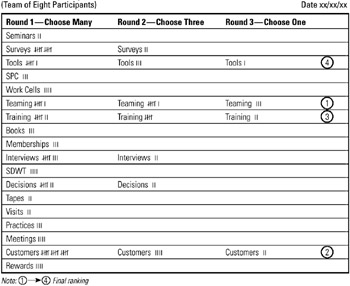Tool 206: Triple Ranking
| AKA | N/A |
| Classification | Evaluating/Selecting (ES) |
Tool description
The triple ranking tool is useful in reducing a long list of items and involves all participants in the discussion, evaluation, and ranking process. The list of items is compared to team-generated criteria, and three rounds of ranking are completed to develop a final list of items that meet the criteria. Open discussions between rounds assist in the clarification and understanding of the listed items.
Typical application
-
To discuss and rank items or issues in order to produce a prioritized list of items or issues necessary as a starting point to build team consensus.
-
To reach team agreement on which ideas, problems, or opportunities should receive allocated resources.
-
To team select what is perceived to be the most important items from a long list of items.
Problem-solving phase
| → | Select and define problem or opportunity |
| → | Identify and analyze causes or potential change |
| → | Develop and plan possible solutions or change |
| Implement and evaluate solution or change | |
| Measure and report solution or change results | |
| Recognize and reward team efforts |
Typically used by
| Research/statistics | |
| Creativity/innovation | |
| Engineering | |
| 2 | Project management |
| Manufacturing | |
| 4 | Marketing/sales |
| Administration/documentation | |
| Servicing/support | |
| 3 | Customer/quality metrics |
| 1 | Change management |
before
-
Brainstorming
-
Round Robin Brainstorming
-
Interview Technique
-
Thematic Content Analysis
-
Affinity Diagram
after
-
Different Point of View
-
Project Planning Log
-
Criteria Filtering
-
Responsibility Matrix
-
Action Plan
Notes and key points
-
The team decides on the criteria by which to evaluate each item.
-
Three rounds of ranking occur, beginning with selecting many, then three, and finally one item per team participant.
Step-by-step procedure
-
STEP 1 The team decides on the criteria by which each item will be evaluated during the ranking process. The appropriate criteria for the example shown are (a) impact or consequence of effort, (b) support of organizational goals, (c) resource requirements, and (d) employee acceptance and feasibility. See example Ideas for Quality Improvement.
-
STEP 2 Team participants compare the list of items to agreed upon criteria. In round 1 participants choose as many of the items as they think will meet the criteria. All choices are tallied by the team facilitator.
-
STEP 3 All items that have received at least five tally marks during round 1 will be included in a now-reduced list for round 2. Further discussion and clarification takes place. Team participants explain why certain items were chosen.
-
STEP 4 Round 2 ranking takes place. This time, each team participant can choose only a maximum of three items. No one can choose a single item more than once per round.
-
STEP 5 Again the list is rewritten by the team facilitator. The items with three or more tally marks are included in the revised list.
-
STEP 6 Team participants now complete round 3 by choosing only one of the remaining items. The final list is ranked based on the number of tally marks, highest to lowest number, as shown in the example.
Example of tool application
Ideas for Quality Improvement

EAN: 2147483647
Pages: 326